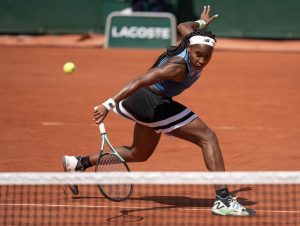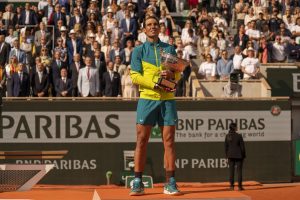For so long, Novak Djokovic has been the most famous ‘Third Man’ since Harry Lime. Even after a phenomenal decade of dominance or near-dominance in tennis, he has still been somewhat in the gigantic shadows cast by Roger Federer and Rafael Nadal, who established their own formidable rivalry (and thereby won their own armies of supporting fans) before Djokovic had even won a single Major. Now, however, after his triumph at the French Open, the great Serb is poised to step out of their shadows completely and become an entirely different kind of ‘Third Man’ – only the third male tennis player in history to complete the calendar (i.e. actual) Grand Slam.
Djokovic has almost been here before – twice. Once before, he has held all four Major Singles titles in tennis at the same time. That was five years ago in 2016, when he finally won the French Open Singles title for the first time, thereby completing the Career Grand Slam and the so-called “Nole Slam” of holding all four Major titles simultaneously, albeit won over two calendar years (2015 and 2016). He almost repeated the “Nole Slam” at the French Open in 2019, when, after emerging from the two-year period in the wilderness that followed the first “Nole Slam”, he was knocked out of the French Open semifinal by Dominic Thiem on a day so windswept that it seemed to totally throw him off his game.
Now, as in 2016, when he had also won the first two Majors of the season – the Australian Open and the French Open – Djokovic is poised for a full-on assault on the official Grand Slam of winning all four Majors in the same calendar year. And this year, unlike in 2016, when the sheer relief of finally winning his first French title seemed to induce a kind of mid-career hangover that lasted for almost 24 months, Djokovic seems absolutely set fair to continue his Major-winning streak at Wimbledon and the US Open.
That is because he has already overcome the single biggest hurdle for any man trying to win the calendar Grand Slam, namely beating Rafael Nadal at the French Open. As appeared almost inevitable even from before Roland Garros started, the semifinal between Djokovic and Nadal was the real final, with the winner likely to overwhelm anyone else they met in the final.
Eventually, that proved to be the case, although not before Stefanos Tsitsipas had won the first two sets in Paris and raised the real possibility that he would claim his first Major title. However, such is Djokovic’s sheer “bouncebackability” (a term originally coined to describe the elasticated Mr Incredible in The Incredibles films but long-ago adopted in sport as the perfect term for mental and physical resilience) that nobody, not even Tsitsipas himself, really thought that the job was done.
There have been many accolades lavished on the semifinal between Djokovic and Nadal since it took place, but it deserves every one of them. In fact, it was almost certainly the greatest clay court match ever played. Obviously, there is recency bias in that assessment, as in any such assessment, but Nadal has dominated Roland Garros for so long that it is impossible to think of a similar match during his long reign that comes close. The only possible candidates are perhaps the finals of 2012 and 2014, also against Djokovic, or the pair’s previous semifinal in 2013. However, nothing in those matches came close to the sheer greatness of the third set between Nadal and Djokovic in 2021.
In 1995, at 5-5 in the Wimbledon Women’s Singles final, Steffi Graf and Arantxa Sanchez Vicario played a game so long and so brilliant that thereafter it has simply been known in tennis as “The Game”. It is surely no exaggeration to say that henceforward the third set between Nadal and Djokovic in this year’s French Open semifinal will simply and succinctly be known as “The Set”.
It is deserving of such immortalising, because even in this greatest of generations in men’s tennis, which has seen a succession of truly historic Major finals between Djokovic, Nadal and Federer, there has never been a single set that has produced so many remarkable winners, rallies and above all astonishing court coverage, where somehow Djokovic or Nadal returned balls that had seemed impossible to reach.
So, having won “The Set”, and soon after the semifinal and final at Roland Garros, Djokovic can now be said to be more than halfway to the calendar Slam. He is the reigning Wimbledon Champion, having already won in London SW19 five times, and with Federer clearly in decline and Nadal withdrawing from Wimbledon because of injury concerns, it is genuinely hard to see anyone stopping him on grass. And so it is likely that the greater challenge will come at the US Open in September, where he will return to the scene of last year’s crime, when he hit a linesperson with a ball struck in anger and was immediately ejected from the tournament.
The memory of that incident is a reminder that perhaps the biggest opponent that Djokovic will now face in the two remaining Majors of the year is himself. Far more than Federer or Nadal, he has been prone to such outbursts of anger and frustration. Even in the French Open quarterfinal against Matteo Berrettini, he celebrated victory with a roar that could have been heard in his native Belgrade. However, if he can keep his emotions in check, Djokovic has every chance of becoming only the third man ever to win the calendar Grand Slam.
It is a top tennis trivia question to ask even tennis fans who are the only two men in the history of the sport (which now extends to about 150 years) to have won the calendar Grand Slam. Some might get Rod Laver, who was so great that he won it twice: once as an amateur, in 1962; and then again as a professional, in 1969, after he and his fellow professionals had finally been readmitted to the sport after being banned for having had the audacity to demand recompense for their brilliance.
The only other winner of the calendar Grand Slam is far less well known, even by dedicated tennis fans. He is America’s Don Budge, who was the first man (indeed, the first man or woman) to win this most celebrated of tennis crowns in 1938, or just before World War Two.
The fact that there has only been one winner of the calendar Grand Slam in the Open Era of tennis (since 1968) and just two in total in the entire history of the sport is probably the best proof of just how difficult it is to achieve. Even the truly great Federer and Nadal have never come close, as neither of them have ever won the first two Grand Slams of the year to take them even halfway to the calendar Grand Slam.
If Djokovic achieves it this year, it will surely confirm him as the greatest male tennis player ever, as he will be the first man to make it to “21 (Majors) in ‘21”. However, a final irony is that he may already have done so, without winning the calendar Grand Slam or passing the 20-Major tally currently shared by Nadal and Federer.
That is because he has already done to the other two members of the “Trivalry” – the greatest rivalry ever in sport – what they have been unable to do to him: beating them, not once but twice, on their favourite surface at their most successful Major. While neither Federer nor Nadal have beaten Djokovic in a final at the Australian Open, the Major he has made his own, he has now beaten Federer in three Wimbledon finals (2014, 2015 and 2019) and beaten Nadal twice at Roland Garros (the 2015 quarterfinal and the 2021 semifinal). That, more than any mere numerical achievement, is surely all the proof that anyone needs that he is ranked first even among this remarkable triumvirate of tennis deities.
Main photo:
Embed from Getty Images






